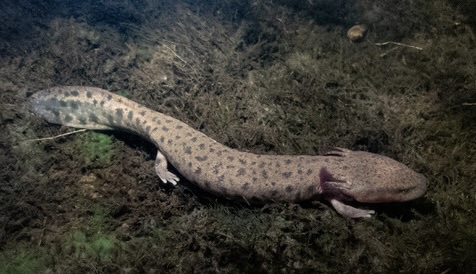submitted by Fred Schueler & Aleta Karstad
Mudpuppies, Necturus maculosus, are giant permanently aquatic Salamanders, which are widespread, but hard to observe, all across Canada, from St Lawrence tributaries east of Quebec City, to the Arctic Watershed in the Ontario Clay Belt, to the Assiniboine River across Manitoba. Unlike other Amphibians, they are most active in the winter, so they are most often seen as by-catch of ice fishing, and are studied by midwinter minnow-trapping.
The one place, in all of Canada, where they are routinely observed in the winter is below the dam in Oxford Mills, where a big population moves upstream onto flat limestone bedrock. In the 1990s, we found that our excitement about the abundance of Mudpuppies in Kemptville Creek was not shared by research funders or regulators, because the species had no sporting, commercial, or at-risk status. In 1999 we began Mudpuppy Nights in Oxford Mills, to publicize the wintry spectacle of Mudpuppy activity, every Friday evening from after Thanksgiving until the creek’s freshet in March. The primary data gathered are counts of how many Mudpuppies are seen between the dam and the bridge, along with counts of other creatures, and records of the ice and water conditions.
The major influence on the number seen is the flow in the creek, since the Mudpuppies can’t walk upstream against a strong current. This year, after a drought-like summer, we had below average flows, lots of Mudpuppies, and few visitors until the beginning of January. Then a massive thaw sent seven times the average flow past the dam, and above average flows, reduced or zero counts, and many groups of visitors continued into March (except for a mid-February decline to average flows, when moderate numbers of ‘puppies were observed). Matt Keevil and Amanda Bennett have done most of the wading and counting, with us elders often staying ashore to regale visitors with Mudpuppy lore. Visitors are invariably thrilled by their first opportunity to relate to these relics of the Age of Dinosaurs.
This year’s Mudpuppy viewing season started up on October 12, 2022 with a Muskrat climbing into the spillway of the dam, a couple of invasive hybrid Crayfish, a scattering of Whirligig Beetles, and a single Black Bass. Through October, the flow in the creek remained very low, and we observed the noses of Mudpuppies poking out from under ledges, Bull Frog tadpoles, Giant Water Bugs, a Water-Scorpion, a couple of juvenile Northern Pike, and Leopard, Green, & Bull Frogs. These conditions continued through December, with the count of ‘puppies peaking at 41 on December 16, one of them seen eating a small frog. The Bull Frog tadpoles had dropped out, perhaps having been eaten by the Mudpuppies. We had visitors from Mississauga, Grégory Bulté brought a class group from Carleton, Steve Marks brought a party from Orillia, and Audrey Turcotte’s herpetology class came from La Cité Collégial in Ottawa.
On December 30, melting snow cover, light rain, and 7°C air temperature raised the creek’s flow to above average on the RVCA’s excellent online graph. The thaw peaked on January 6, washing up under the lit-up Christmas tree on the west shore below the dam, rushing along at 33 cubic metres/second, when the average flow for the date is 4.6 cubic metres/second. On January 13, the spillways were widely open, but with ice and snow drifts along their sides, and waves filled with lumps of ice washing up against the wall on the east side.

Creek flow subsided in later January and the beginning of February, with modest numbers of Mudpuppies, a few frogs and Crayfish, a couple of juvenile Pike, and Otter tracks in the snow. On February 3, we had the one cold snap of the winter, at -26°C, and lots of frazil ice and loose pans in the eddies, but 11 Mudpuppies were seen, and on 6 February, there were 15 Mudpuppies, including one that was 32.5 cm long, the largest we have measured at Oxford Mills. Visitors included a crew from South Nation Conservation, another from Blazingstar Environmental, Prince Edward County Field Naturalists, and a party from Peterborough.
There was more high water later in February, but on March 3 the flow was down to 113% of normal, and we astonished students from Carleton and Queens universities with three Mudpuppies and two big Crayfish. With March coming in like a lion, flows were only half of normal on the 15th, and we were able to catch and retain two ‘puppies to be viewed by a group of “elderly ladies” from Ottawa and Gatineau, visiting the Brigadoon Restaurant for lunch. Cold weather continues to be forecast, so we don’t know how much longer mudpuppying will continue.
With the irregular weather we’ve been having in recent years, it seemed that after 2012, with the arrival of abundant invasive Crayfish, we saw fewer Mudpuppies, but it will take a careful statistical analysis to be sure. In recent years, with many fewer Crayfish, there seems to have been an increase, and especially an increase in the percentage of small individuals. A friend did a regression of the Mudpuppy counts on flow for a course at McGill, and found that the decrease was significant, but this was before we saw the subsequent apparent increase.
We hope that this year’s increase of students visiting will inspire new research into the ecology of Mudpuppies and the creek. In the summer we’ll be doing “craypuppy” wades, which will introduce participants to the Mudpuppies, Crayfish and other creatures and plants of the creek. If any group or family wants to arrange one of these, just let us know (Fred bckcdb@istar.ca or Aleta karstad@pinicola.ca).








here are some early accounts of the invasive Crayfish – http://www.doingnaturalhistory.com/search?q=oxford+crayfish – https://ngtimes.ca/attack-of-the-hybrids/
“the RVCA’s excellent online graph” is https://his.rvca.ca/rvcafwl/ISG/StandardGraph_KemptvilleCreek_Hourly.html